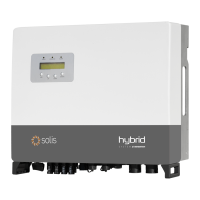3. Installation 3. Installation
.23..22.
3.4.3 Connect grid side of inverter
1). Connect the three (3) AC conductors to the three (3) AC terminals marked “L1”, “L2” and
“L3”.Refer to local code and voltage drop tables to determine the appropriate wire size
and type.
2). Connect the grounding conductor to the terminal marked “PE” (protective earth, the
ground terminal).
WARNING
An over-current protection device must be used between the inverter and
the grid.
NOTE
Use AL-CU transfer (bi-metallic) terminal oranti-oxidantgreasewith
aluminumcablesandterminals.
3.4.3.1 Connecting the inverter to the utility grid
All electrical installations must be carried out in accordance with the local standards and
the National Electrical Code® ANSI/NFPA 70 or the Canadian Electrical Code® CSA C22.1.
The AC and DC electric circuits are isolated from the enclosure. If required by section 250
of the National Electrical Code®, ANSI/NFPA 70, the installer is responsible for grounding
the system.
The grid voltage must be within the permissible range. The exact operating range of the
inverter is specified in Section 9 “Specifications”.
NOTE
The AC output neutral is not bounded to the ground.
The neutral wire is not necessary for the installation.
Over-Current Protection Device (OCPD) for the AC side
To protect the inverter's AC connection line, we recommend installing a device for protection
against over-current and leakage, with the following characteristics noted in Table 3.2:
3.4.2.1 DC connection high voltage danger notice
CAUTION
RISK OF ELECTRIC SHOCK
Do not touch an energized DC conductor. There are high voltages present when PV modules
are exposed to light causing a risk of death due to an electric shock from touching a DC
conductor!
Only connect the DC cables from the PV module to the inverter as described in this manual.
CAUTION
POTENTIAL DAMAGE TO THE INVERTER DUE TO OVERVOLTAGE
The DC input voltage of the PV modules must not exceed the maximum rating of the inverter.
(see Section 9 “Specifications”)
Check the polarity and the open-circuit voltage of the PV strings before connecting the DC
cables to the inverter.
Confirm proper string length and voltage range before connecting DC cable to the inverter.
Requirements for the PV modules per MPPT input:
● All PV modules must be of the same type and power rating.
● All PV modules must be aligned and tilted identically.
● The open-circuit voltage of the PV array must never exceed the maximum input voltage of
the inverter, even at the coldest expected temperature. (see Section 9 “Specifications” for
input current and voltage requirements)
● Each string connected to a single MPPT must consist of the same number of series-
connected PV modules.
Table 3.2 Rating of grid OCPD
Inverter
Rated
voltage(V)
Max output
current (Amps)
Current for protection
device (A)
Solis-125K1-EHV-5G
120600 150(265A Max)

